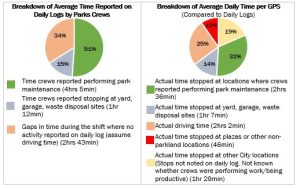
Why This Audit Matters
Beautiful, clean and safe parks are important community spaces that contribute to the quality of life in Toronto’s communities. City crews of the Parks Branch are responsible for maintaining the City’s parks to ensure service level standards are met.
Background
This report presents the first phase of the audit which aimed to answer the following questions:
• Are factors such as classification/size, location, usage (including unintended types of usage) of the park considered when implementing operational maintenance service standards?
• Are operational maintenance activities assigned and completed in a manner that maximizes crew productivity and achieves service standards?
By The Numbers
- 604 vehicles used by Parks Branch; 192 (32%) City vehicles do not have GPS installed
- 46% of daily logs in our sample where GPS indicates crews did not stop at 1+ park locations
- 86% of daily logs in our sample where GPS indicates crews stopped near retail establishments, eateries, industrial areas, residential addresses, and/or places of worship
- 75% of daily logs in our sample where GPS indicates the time in/time out at many locations was not accurate
- 28% of daily logs in our sample did not indicate which maintenance activities were completed at 1+ park locations
- 13% of daily logs in our sample were not signed off by a Foreperson or Supervisor
What we found
A. Leverage Technology and Improve Scheduling, Tracking, and Monitoring Processes
-
- Parks Branch was not using GPS to regularly monitor crews. Not every vehicle was equipped with GPS technology.
- Parks Branch uses daily logs to schedule and track work completed. Daily logs were not always properly completed. Park locations and working times were not always accurately reported and did not always match GPS records.
- On average, in a standard 8-hour work day, mobile crews reported over 4 hours (51%) a day at parks maintenance locations compared to the 2 hours and 36 minutes (32%) indicated by vehicle GPS information. As illustrated in the figure below:

- Most records were paper based making it difficult to aggregate data for the purpose of analyses and comparison across the districts and for strategic decision making.
B. Strengthen Monitoring and On-site Supervision of Daily Maintenance Activities
- Nature and extent of monitoring varied between districts and Supervisors.
- No specific operational policies or guidelines to provide direction to Supervisors on matters such as what Supervisors are expected to review, document, communicate and follow-up on when conducting park visits/inspections.
C. Set Performance Expectations and Measure Outcomes
- Parks Branch was not consistently achieving its service level standards in June and August 2023 for parks we sampled.
- Key performance indicators have not been developed to measure compliance with the established service level standards and Parks Branch does not aggregate data to be able to monitor performance against service level standards because records are paper based and of poor quality.
How Recommendations Will Benefit The City
Implementing the nine recommendations in the report will enable the Parks Branch to improve its scheduling, tracking, and monitoring processes for parks maintenance, improve crew productivity and supervision of parks maintenance activities, and help in achieving service level standards reliably and consistently across all city parks.